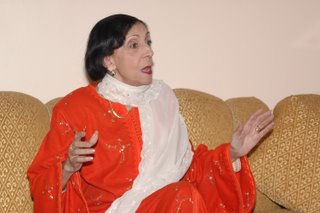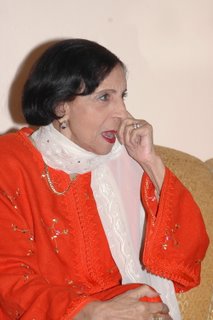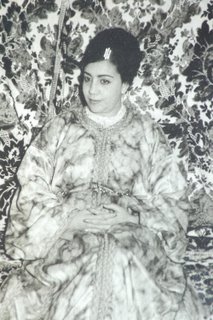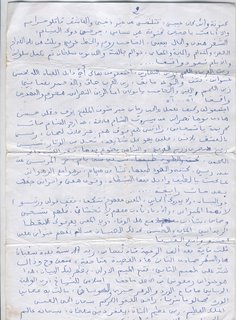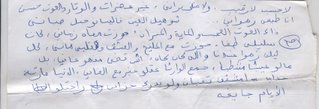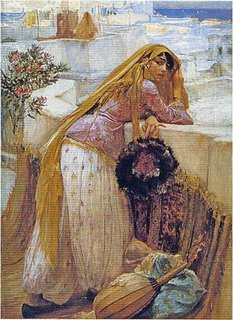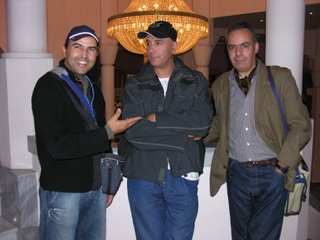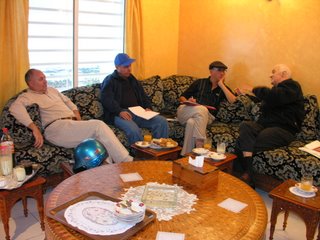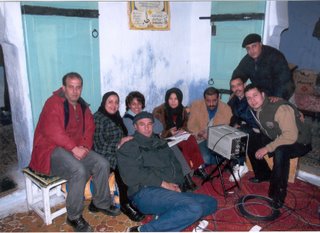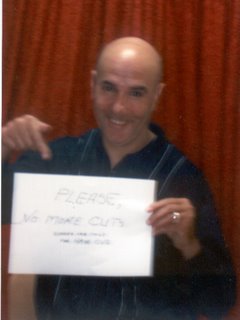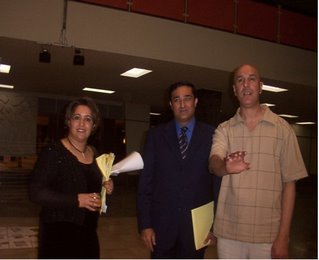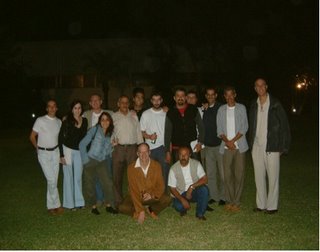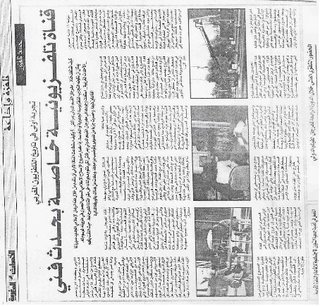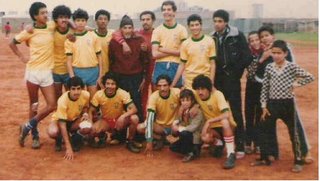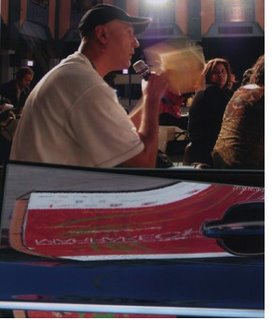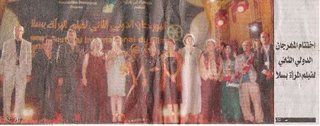

This Photo was maade by OSCAR
MOROCCO BOUND TO HINDI CINEMA
Finished with those gaudy and strange movies in India named the masala films (1) ,New Indian cinema lightens the world with its beautiful stars and show-business and even locally Moroccan bollyphiles are continuously becoming more Hindi fans than ever.
Arrived at the Golden Tulip hotel which faces a rising millennium town of Morocco called Salé (2) , Bina Paul a south Indian woman of Kerala, which is a magical place in Asia said to me why Salé film festival has not chosen an Indian film for competition this year 2006. Bina Paul is an artistic director and member of Kerala International film festival in the south of india . She came to Salé to become a member of jury of the International Women Ffilm Festival .
Salé was famous of her cinema theatres such as Collisé, El Malaki and Opera . Although some of them were used as cinéclubs in the sixties especially the Opera theatre .That time left-thinkers were very enthusiastic about culture. Thanks to these intellectuals namely Nour Eddine Sail (3) Abdel kader kaderi and Dr Amallah , cinema was highly promoted and the interest of making films was so big . Other cinemas just could not resist to project Indian movies just like « classical ragas » Dosti by Saten Bose and Mother India By Mahoob . Just after independence named proudly, the goden age,Hindi films were dubbed into Moroccan slang(Arabic) by local pioneer artists namely Ibrahim Essaih (4) , Hamidou ; Mostapha Mounir and other actors and actresses.
Ibrahim Essaih was right to dubb indian movies that time, because the
majority of the Moroccans were analphabets . Local Rabat intellectuals keep
making pressure on Moroccan governement to increase the budget for cultural purpuses.Yet,movies were nationally done in a shy manner, 2 films per year until the recent fund policy,which CCM, the National Center of Cinema has made ;14 to 30 fims per year.
‘Hindi cinema has been a major point of reference for Indian culture in this century. It has shaped and expressed the changing scenarios of modern India to an extent that no preceding art form could ever achieve. Hindi cinema has influenced the way in which people perceive various aspects of their own lives. With one mighty leap, Bollywood has gone from melodrama to youthful reality, reports Kevin Maher,The Times journalist In England.’
It is true that filmmakers in India have been plagiaristic to the extent that even Hollywood would remake Munnabhai MBBS and becomes Gangsta MD ;an American movie by Chris Tucker. The ‘seven Samurai’ by Akira kurasawa inspired Ramesh Sippy ,and artistically became ‘ Sholay ‘ in 1975 .
Thanks to Ismail Noor Mohamed Abdul-Rehman , known as Ismail Merchant, Indian cinema becomes worldwild and because of his great talent as a producer and director , every good actor in the west would love to work with him . « This man sells dreams of elegance and beauty, of dignity and propriety, of literate splendour and intellectual stature and above all, of traditional reverence and venerable taste,Lubna aziz writes on Al Ahram weekly. » This seems contrary to the thoughts of Moulay Driss Jaidi and local faked critics who state that Hindi movies have bad taste on Moroccan cinemagoers .
Unlike CIFF , Cairo International film festival and carthage film festival , FIFM,the International film festival in Marrakesh, focuses only on European and American cinema and badly to Asiatic films. It is time that Maghreb mainly Morocco think of new encouraging debates and meetings in the future of Hindi cinema, because of the arising bollyphiles warching 80 new indian films per year out of 350 imported films .This information is confirmed to me by Kamal Mghazli, an employee of CCM, Moroccan National Center of Cinema based in Rabat spearheaded by Nour eddine Sail.
India now is one of the largest film producing nations in the world, an average of 800 films per year.In 2001, the industry had a jump 1,013 films were made and got 4.5 billion rupees in revenues.
Interviewed with a house of film distribution , Amal films based in Casablanca has stated that although the prevailing of CDs and DVDs , Bollywood cinema remains poweful in consuming and still welcomed in Morocco especially now public television of holding SNRT and 2M are interested to diffuse films such as Devdas , Lagaan and Veersaara highly praised by international critics around the world. I don’t know what other anti-bollywood think about recent statistics of Hindi Box office made by CCM that in 2003 Morocco imported 378 Hindi films , the number of fans were 3 783602 and ticket revenues were 36101026. Although CCM confirms that these statistics are not fully complete , but in 2006 up to june the number shifted to 264 Hindi films and ticket revenues were 581800.Other statistic could not be done by CCM because of lack of infrastruture. This means in CCM , they started to archive Hindi movies in 2002.
Sometimes ships don’t head for the direction it wants. ‘ Even in America and very often, Oscar nominees and winners are selected on the basis of considerations other than strictly artistic merit. This means, good cinema suffers, writes Bhaskaran, an intellectual Indian’. Prabably we won’t see any Hindu film being selected on competition this year in Marrakech 2006 just because there are still some constipated mentalities and old fashioned bureaucracy that favor American and Eureopean films than any good Asia films . FIFM, bureau de la fondation (5) should think this matter seriously about Bollywood cinema because apparently the cinemagoers and producers already think of Morocco as a magical place to shoot future films instead of making them in Swisland .This European country makes heavy taxes on commercials films favored by the legendary producer Mukesh Bhatt (6) . Besides, Morocco is still open to all Indian producers to work by showing easy policy to show-business .CCM has now two recorded clips ,one is Naach produced by Varma corporation limited, shot around Tangier, Marrakech,Agadir , Essaouira and the second is Halki Need/Saru produced by Corner pocket films , shot in Marrakesh and Essaouira .
Quentin Taratino and Micheal Moore , famous and respected filmmakers in America ,encourage to free-download their films, unlike Amitabh Bachchan, a mega-star and ambassador of IIFA ; International Indian Film Academy , disagrees about hacking films and resumes that this matter becomes a major problem and it is difficult to solve . Thanks to Free market and Internet, cinephiles now enjoy to have a lot of good films with good quality at home including the Indian ones. However, CCM locally keeps an eye on outlaw CDs and DVDs dealers Derb Rhallef (7) in Casablanca and Swika, Bab El Had called the Quissaria Aît Baha (8) in Rabat . CCM have recently Seized 400,000 CDs and DVDs approximatively 5.000.000 dhs.In 2005,the number of the seized CDs was 888.084. They contain all new hacked genres of International cinema including Bollywood films. CCM intends to fight against films hackers and hopefully cinema theatres will be open again.
Salé city itself suffers a lot of cinema theatres being closed including Dawliz complexes (9) owned by an ex- CCM super head . Now, in Salé there is only one cinema open , found in a popular ghetto called El Wad (10) . This cinema theatre is called Hollywood. It ironically does not accept other types of movies only bollywood films. This city has tremendous tenderness in its past when it memorizes one of the first handy-made cinema called the beloved Abderahim. He worked manually and impressed Slawi kids in the sixties . Artistically , Abelrahim combined voice-over with the rolling images.
the International Women Film Festival in Salé was unlucky this year to have an indian film in competition but it could have thought only one of those three womenish films that deal with ‘ modern feminism’ in India traditions namely « ‘Mohra » 1994, Mother India, made in 1957 by Mehboob and « Mirch Masala », made in 1989 by Ketan Mehta. Among the guests ,Salé could have called Jaya Bachchan who starred in Satyajit Ray's Mahanagar (The Big City 1963). This type of cinema is called art films in India which is more stylish treating human conditions .It is similar to the cinema d’auteur in France. No doubt that Mira Mair a filmmaker installed in America , famous of her « Salaam Bombay » and now with her latest film « Namesake » wakes up America and Europe to recognize the potential of Indian cinema .
Bollywood shifts gracefully from making movies of impossible love to firing subjects . « From Guru Dutt’s Sahib Bibi Aur Ghulam to Hrishkesh Mukharjee’s Abhiman to Aziz Mirza’s Chalte Chalte, the morning after the wedding reception has been looked at from various angles. There is a plethora of complications to choose from. And infidelity tops the list. Stories of infidelity have found many takes. But making a film that deals with infidelity is like playing with fire. Most of the filmmakers make sure they’re suitably insulated. »
Indian Cinema has always been loved by Moroccan cinemagoers and bollyphiles and even since its early start with legendary Dhundiraj Govind Phalke (1870 - 1944) affectionately called Dadasaheb Phalke is considered as the 'father of Indian Cinema'. « Central in Phalke's career as a filmmaker was his fervent belief in the nationalistic philosophy of Sswadeshi movement, which advocated that Indians should take charge of their own economy in the perspective of future Independence. »
This was confirmed to me by the most talented filmmaker Yash Shopra who was in Marrakech in 2005 with his wife, Pamela Chopra . Going around Marrakeshi souks and suburbs especially the Jamaa el Fna (11) square, Yash shopra said how amazed and astonished he was by the Moroccan people and its traditions that really has great affinity with the ones in India.With my gaudy and showy english,i wanted to impress my colleagues.Yash Shopra consciously was aware what i intended to do , he asked me gently to be reasonable. Using his Shokriya hand,the master begged me to ask him in a simple english. I knew then that he was gentlman in his manner and giant to direct his beloved artists. Both India and Pakistan Should be grateful for the symbolic union that gathers these two countries through Veersaara By Yash Shopra.It is an outstanding drama which tries to break the barriers separating two lovers, Veer Patra Sing (Shahrukh kan) and a Pakistani woman , Zarra Hayaat Khan (Preity Zinta). When he projected his film at Berlin film festival, Yash Shopra was scared that the people would not understand the story , However ,at the end of the film, he saw people crying. The presence of Aishwarya Rai in Marrakesh , a former Miss World and Bollywood’s first genuine cross-over icon, , lightened Marrakech with her beauty and let all Marrakeshi young men eyes wild open. These artists are well honored by the Moroccan people and FIFM,the international film festival in Marrakesh. Morrocco now became known in Mumbay and the majority of Bollywood stars would love to come to it .
Not far from Agadir, Las Palmas , a spanish litttle island, is overcrowded with indians and enjoyed the double culture there. « Indians have immigrated to every corner of the globe with contingencies in South Africa, the Gulf countries, Singapore, Australia, New Zealand, US, Canada apart from the UK. Wherever the Indians go, their films and their food go with them. With curry and chutney now international favourite foods, it was inevitable that their exotic films, their melodies, the romantic strains of their sitar, the striking beauty of their leading ladies and the dark and daring magnetism of their dashing heroes would eventually reach the hearts of the West despite all of Rudyard Kipling's poetic protests, reports Lubna Abdel Aziz, from Cairo Al Ahram weekly . Of course, he did not know then the strength and might of the Seventh Art, which proved to be the best meeting ground for East, West, North and South ».
Many critics in Morocco would immeditaly judged Indian cinema as an emotional cinema which only seeks imposssible love, and therefore damages the taste with its chosen six songs and pharonic scenes . Yet,it is praised and admired by others just like Razak, a Hindu fan and film critic who is illuminated by its new wave , indepentent anti-studio cinema , pioneered by Madhur Bhandarkar .Razak continiously makes local cinephiles more aware about Indian cinema using his power as a wonderful plume .He writes how exquisite , beautiful and magnificanctly arising and yet glorifying world wild Hindi cinema is. He also predicted in his RABAT EXPRESS newspaper that « BLACK » of Sanjay Leela Bhansali with Amitabh Bachchan and Rani Mukherjee as best actor and actress ,would win an Oscar in Dubai during IIFA film festival this year 2006.His prophecy became true in the United Arab of Emirates last june during IIFA ceremony in Dubai. By the way, the Arab world is also fascinated by this genre of Cinema .Whenever you go, Bollywood movies prevail in popular theatres, for example ,Cairo,casablanca and Dubai cinemas are full with bollywood fans, and you can hardly find your ticket. Now resoursefully, people in Mumbay listen carefully to European cinephiles who admire latest of Sanjay Leela Bhansali « BLACK » because simply of its new style without using songs and exotic scenes.
Ideas like creating an agency that deals only with Bollywood films and Wizcraft artistic communications becomes a wish not only for Razak , Ahmed
Sijilmassi but also for Abdelillah Al Jawhari and Allal El Alaoui (12) . Those tink-tanks see that it is time to sit down, and dicuss continuous meeetings between film distributers, producers and fimmakers. Even touchy subjects could be tackled let alone the mechanism and future of Indian cinema.
Since the The first film in Southern India was made in 1916 by R. Nataraja Mudaliar- Keechaka Vadham, the hindu wish to impose their style of making films . Now thanks to Wizcraft policy, India’s first and premier event management and entertainment agency, pioneered by Wiz Andre Timmins , Wiz Viraf Sarkari , Wiz Sabbas Joseph . These men are continuously giving power to IIFA to become more world class ceremony.
- 2000 : London,United Kingdom.
- 2001 : Sun City,South Africa.
- 2002 :Genting Highlands, Malaysia.
- 2003 :Johannsbourg,South Africa.
- 2004 :Songapore.
- 2005 :Amsterdam,The Netherlands.
- 2006 :Dubai,UAE.
-
Morocco has,alas, missed this year 2006 appointement, but rumours say that 2008 IIFA awards will be one hundred per cent Moroccan(In ChaAllah) . This pushes Yorkshire to swiftly call for IIFA festival to be held in its land.So, Lata Mangeshkar, a Guiness record holder, Mukesh, Mahmood Rafi and Kishore, will sing Godlike lyrics to beautify British souls . Yorkshire lads and birds including five millions Asians would enjoy beautiful movies when they would put the kettle on.
Yorkshire then hosts IIFA , the international Indian film academy awards , oscar-style and is backed by brillant staff of Yorkshire tourist Board whose chairman is Judith Donovan including members of YTB such as Sir Thomas Ingilby , Colin Brown , Zulfi Karim, Cllr. Carl Les and others .They already mise-en – scene the platform of the seventh edition festival already called – Love at first sight.
Surely the seventh edition of the IIFA festival will shake cinema lovers and bollyphiles around the globe especially Yorkshire plays the leading cultural link between the fiveth continent. Stratford -upon - even where William shakespeare is born ; a few kilometres from quintessential Yorkshire towns where the festival will be held , Richmond Old theatre eighteen century and the glittering town Leeds ,these local cultual treasures of England will be glittering .
Famous personality & Celebrities will invade British Islands mainly Amitah Bachan, Karishma Kapoor, Aamir Khan, Kajol, Madhuri Dixit and Shah Ruhk Khan who reports on himself ‘I have created a myth. Sometimes I think of myself in the third person – I’m ‘the’ Shah Rukh Khan now. He’s a brand of his own. It’s not me any more. Now a myth is created. This is what my films have created. That myth can be called King Khan.’Sonu Nigam called the golden boy of the pop songs in India,gives his voice to Shah Ruhk Khan when dubbing a movie.Anyone who takes Nigam’s voice will be a star .
Yorkshire expects millions and millions of tourists from around the world. The event is expected to boost tourism income across the region by nearly 10 million pounds. The inaugural IIFA awards event was held at London's Millennium Dome in 2000. The summer of 2007 is also expected to attract nearly 30,000 people from Europe, India, southeast Asia and the US, and signifies the exalted status the Indian film industry has attained in Britain.
FIFM bureau de la fondation, CCM (13) and house distibution in Morocco should consider and give importance and value to Hindi cinema and especially the taste of passionate Moroccan people who just love Bollywood. In academic circles here, LA Times (14) reports that Indian films are no longer seen as quaint, gaudy and oriental items, but a resilient cultural powerhouse in the subcontinent that challenges the near-global domination of Hollywood films.
Muqtedar Khan (15) writes that India is already well situated to become a major economic and cultural power worldwide. Indian culture, through the popularity of Indian cinema, is already giving India the kind of "soft power" that only America enjoys worldwide.
Bina paul will never forget Salé and its traditions . With her digital camera , she took pitures of women tatooing their hands with El Hana, a spiritual herb also used in India for the same purpose.She carefully took notes of those women making their spiritual journeys to Marabouts (16) . This reminds Bina of her people doing the same pilgrimage not of course to Marabouts, but to cinema theatres where they expect a good ending of shining heroes , widows and homeless children.
Coming out from El Madrassa al Bouanania (17), bina paul amazed by its marvellous Islamic frisks , remembered her colleague filmmaker Adoor Gopalakrishnan from Kerala saying that India has always been an immence bazar of images .
ALLAL EL ALAOUI
Zhor idrissi : secretariat.
• International women cinema in salé.
• Centre national de la cinematographie.
• www.CCM.ma.
• Noureddine sail ( CCM ).
• Kamal Mghazli ( CCM ).
• Ahmed Araib ( CCM ).
• Razak ,( rabat express).
• Al ahram weekly .
• Lubna aziz from al ahram weekly.
• Le monde diplomatique.
• The times, UK.
• LA TIMES.
•
1- the masala films : The 1970s saw the advent of the multi-generic entertainment extravaganza replete with dramatic dialogue and spectacular song and dance sequences.
2- SALÉ : A millinuim town in Morocco .
3- Nour Eddine Sail is a Moroccan thinker and cinema critic and head of the main cinema institution of cinema called CCM.
4- Ibrahim Essaih is a Moroccan Indian film dubber . He was the pioneer of dubbing Hindi films after the independence.
5- FIFM bureau de la fondation is an institution in Morocco that organizes International film festival.
6- Mukesh Bhatt is film producer in India.
7- Derb Rallef is a popular market in casablanca where one can find any goods.
8- Swika is a popular market in Rabat .
9- Dawliz complexe is a Place of entertainement, restaurants and luxuary cinemas in Salé .
10- EL Wad : a dangerous Ghetto in the north of Salé .
11- Jamaa el Fna square : one of the most famous entertainemnt souk in Marrakesh ( see UNESCO) .
12- Razak, Ahmed Sijilmassi, Al Jawhari and Allal El Alaoui ; Cinéphiles and intellectuals ,on line free-writers and especially Indian movie fans and critics .
13- CCM is a national institution of cinema that is strictly administratif dealing with distribution , Film visas , festivals and co-ordinations
14- LA Times : Los Angels Journal in America .
15- Dr.Muqtedar Khan is an Assistant Professor in the Department of Political Science and International Relations at the University of Delaware.
16- Marabout is a spiritual leader or saint in Morocco.
17- El Madrassa al Bouanania is an old medieval univeristy in Salé famous of its superb arabisque frisks and mosaique.
